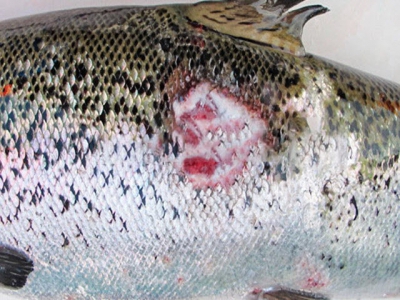Fish disease guide - Salmonid Rickettsial Septicaemia
Salmonid Rickettsial Septicaemia is considered to be the most important disease problem in the Chilean salmon farming industry
 Fish disease guide - Whirling Disease
Fish disease guide - Whirling Disease Whirling disease is a chronic disease caused by Myxobolus cerebralis, a parasitic protozoan that affects mainly juvenile salmonids.
 Coated salt supplements may boost fish biomass gain, feed efficiency
Coated salt supplements may boost fish biomass gain, feed efficiency Adding coated forms of sodium butyrate to tilapia feed may boost biomass gain, fish yield and improve feed conversion, say researchers.
 Fish disease guide - Sea Lice
Fish disease guide - Sea Lice 'Sea lice' is a term used to describe many species of ectoparasitic copepods of the genera Lepeophtheirus and Caligus.
 Fish disease guide - Infectious Pancreatic Necrosis (IPN)
Fish disease guide - Infectious Pancreatic Necrosis (IPN) Infectious pancreatic necrosis (IPN) is an infectious viral disease that affects numerous species of fish in many different parts of the world.
 Alabama catfish, feed producer files for bankruptcy
Alabama catfish, feed producer files for bankruptcy Citing catfish imports and regulatory changes, SouthFresh Aquaculture is filing for bankruptcy and asking for the chance to pay some bills during a company
 Fish disease guide - Furunculosis
Fish disease guide - Furunculosis Furunculosis is highly contagious disease that affects fish of all ages. Aeromonas salmonicida, the infection causes high mortality in salmonids
 Fish disease guide - Gyrodactylus Salaris
Fish disease guide - Gyrodactylus Salaris Only Atlantic salmon are severely affected by this parasite, although G. salaris has been reported from Atlantic salmon (Salmo salar)
 Vegetable choline may boost tilapia growth, antioxidant status
Vegetable choline may boost tilapia growth, antioxidant status Supplementing Nile tilapia diets with vegetable choline may support fish growth and performance along with providing clues to how that response is triggered
 Fish disease guide - Enteric Septicaemia of Catfish
Fish disease guide - Enteric Septicaemia of Catfish Enteric septicaemia of catfish, or Hole-in-the-Head disease, is caused by the bacterium Edwardsiella ictaluri, which belongs to the family Enterobacteriaceae.
 Fish disease guide - Viral Haemorrhagic Septicaemia (VHS)
Fish disease guide - Viral Haemorrhagic Septicaemia (VHS) Viral haemorrhagic septicaemia (VHS) is historically a disease of farmed rainbow trout (Oncorhynchus mykiss) in fresh water in continental Europe.
 Fermented soybean meal may support fish gut health, fishmeal replacement
Fermented soybean meal may support fish gut health, fishmeal replacement Fermenting soybean meal may improve digestibility, antioxidant capacity and immune response when the alternative protein replaces fishmeal in farmed Japanese
 Fish disease guide - Enteric Red Mouth Disease
Fish disease guide - Enteric Red Mouth Disease The causative agent of enteric red mouth disease is the bacterium Yersinia ruckeri. The disease is known to affect a wide variety of fish of all ages.
 Even fish like pizza: By-product meal may drop feed price, support tilapia growth
Even fish like pizza: By-product meal may drop feed price, support tilapia growth Pizzeria by-product may support tilapia growth and development while lowering feed costs for producers using biofloc production systems, say researchers.
 Fish disease guide - Infectious Salmon Anaemia (ISA)
Fish disease guide - Infectious Salmon Anaemia (ISA) Infectious salmon anaemia (ISA) is an infectious viral disease of Atlantic salmon (Salmo salar L.). The disease was first reported in Norway in 1984
 Fish disease guide - Infection with Infectious Spleen and Kidney Necrosis Virus (ISKNV)
Fish disease guide - Infection with Infectious Spleen and Kidney Necrosis Virus (ISKNV) ISKNV-like viruses are a group of viral agents in the genus Megalocytivirus. These viruses predominantly cause disease in a variety of freshwater fish
 Fish disease guide - Infectious Haematopoietic Necrosis (IHN)
Fish disease guide - Infectious Haematopoietic Necrosis (IHN) Infectious haematopoietic necrosis (IHN) is an infectious viral disease of salmon and trout. It was first recognised in the 1950s in sockeye and chinook salmon.
 Cutting aquaponics costs is more than pot luck
Cutting aquaponics costs is more than pot luck Supplying cannabis for medical use in Canada – which is legal for licenced producers – is a competitive business. Based in Hamilton, Ontario, Green Relief Inc
 Fish disease guide - Channel Catfish Virus Disease (CCVD)
Fish disease guide - Channel Catfish Virus Disease (CCVD) CCVD is caused by a herpesvirus. It is known to affect Blue and Channel catfish. The disease mainly occurs in fish that are less than one year old
 Fish disease guide - Bacterial Kidney Disease (BKD)
Fish disease guide - Bacterial Kidney Disease (BKD) Bacterial kidney disease (BKD) is a chronic bacterial disease first reported in wild Atlantic salmon populations in the rivers Spey and Dee in Scotland in 1933
